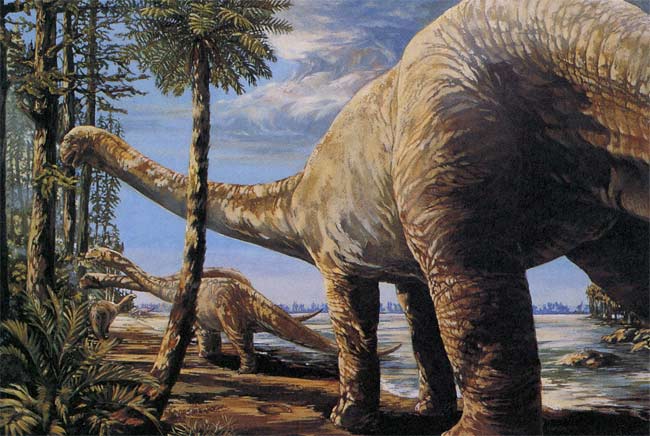Mistaken Identity: Texas State Dinosaur Needs Name Change

Not every state in the nation has a state dinosaur, but Texas does. Now, however, the extinct creature could get a new official name.
It makes sense that the state of everything giant would celebrate a behemoth paleo-beast. In 1997, the legislature named Pleurocoelus the Texas state dinosaur. The sauropod (member of a group of plant eaters with long necks and tails) apparently plodded on saucer-like hind feet and weighed 40,000 to 90,000 pounds (18,000 to 40,000 kg), with a body length of up to 60 feet (18 meters).
The reign of Pleurocoelus in the Lone Star State may be a short one, though.
On Jan. 7, State Rep. Charles Geren of Fort Worth filed a resolution to change the state dinosaur from Pleurocoelus to Paluxysaurus jonesi to correctly name the massive sauropod whose tracks and bones litter the Jones Ranch, which is in central Texas near Glen Rose. Geren filed his resolution on behalf of constituents at the Fort Worth Museum of Science and History.
"I think it's going to be good for Texas paleontology and dinosaur research in general," said Aaron Pan, the museum's curator of science. "This dinosaur is unique to Texas, and it is the most abundant dinosaur fossil found in the Glen Rose area."
Many of the world's most interesting dinosaur discoveries have come from North America. In addition to Texas, just a handful of states have officially designated a state dinosaur, including:
- Colorado: Stegosaurus
- District of Columbia: Capitalsaurus
- Maryland: Astrodon johnstoni
- Missouri: Hypsibema missouriensis
- New Jersey: Hadrosaurus foulkii
- Wyoming: Triceratops
The call for a name change is the result of 2007 research in the journal Palaeontologia Electronica in which Peter Rose, then at Southern Methodist University in Dallas, disputed the Texas dinosaur's identity.
Sign up for the Live Science daily newsletter now
Get the world’s most fascinating discoveries delivered straight to your inbox.
Rose analyzed sauropod bones at the Jones Ranch (in and around Paluxy River near Glen Rose). His analyses showed the bones didn't match up with Pleurocoelus bones first found in Maryland in the late 1800s. The Texas dino had been given the same name as what was thought to be its counterpart in Maryland.
In fact, the dinosaur remains in Texas belong to a completely new genus and species, Rose said. Paluxysaurus jonesi lived some 112 million years ago during the Cretaceous Period (144 million to 65 million years ago).
Rather than a complete mistaken identity, Rose points out scientists had never thoroughly examined the dinosaur fossils littering the state.
"At the time sauropod tracks and bones were first discovered in Texas, only Pleurocoelus was known from North America for this particular time period (Early Cretaceous)," Rose told LiveScience. "In 1974, Wann Langston Jr. described some sauropod fossils from central Texas that he determined to be similar enough to those from Maryland that he referred them to the genus Pleurocoelus."
He added, "I think from that point on, all subsequent sauropod discoveries in Texas were assumed to be that genus as well."
- Dino Quiz: Test Your Smarts
- Avian Ancestors: Dinosaurs That Learned to Fly
- Image Gallery: Dinosaur Fossils
Jeanna Bryner is managing editor of Scientific American. Previously she was editor in chief of Live Science and, prior to that, an editor at Scholastic's Science World magazine. Bryner has an English degree from Salisbury University, a master's degree in biogeochemistry and environmental sciences from the University of Maryland and a graduate science journalism degree from New York University. She has worked as a biologist in Florida, where she monitored wetlands and did field surveys for endangered species, including the gorgeous Florida Scrub Jay. She also received an ocean sciences journalism fellowship from the Woods Hole Oceanographic Institution. She is a firm believer that science is for everyone and that just about everything can be viewed through the lens of science.









